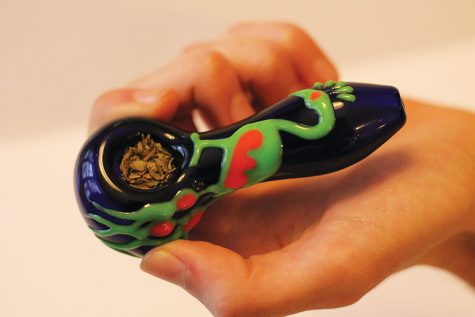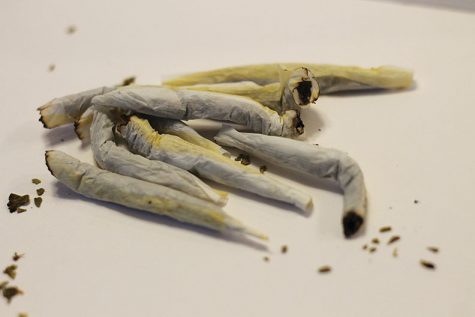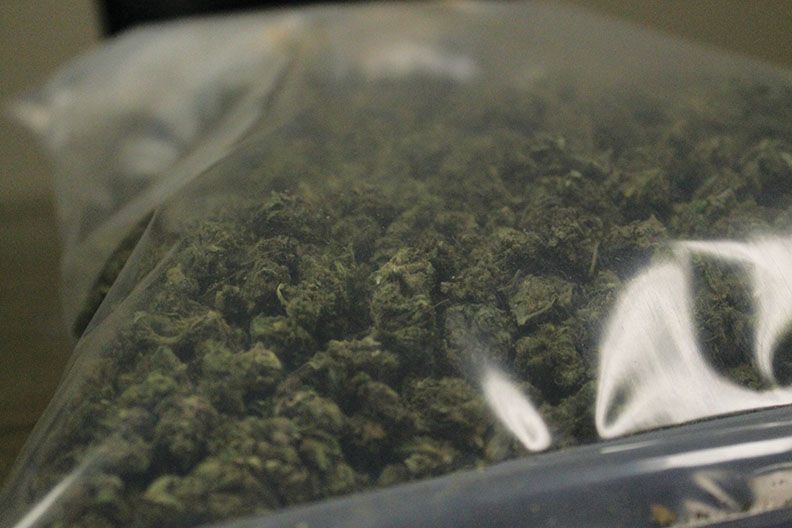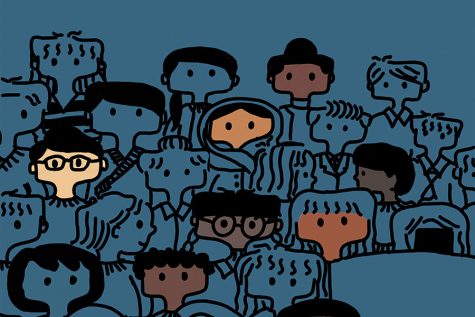Your donation will support the student journalists of West High School. Your contribution will allow us to purchase Scholarship Yearbooks, newsroom equipment and cover our annual website hosting costs.
High stakes
As states across the nation legalize recreational marijuana, the drug has become more socially acceptable. For Iowan students, acceptance of marijuana has grown, but laws haven't changed. However, concerns for increased teen drug usage and safety still prevail.
April 12, 2019
 It’s a summer night, just a few weeks before you start high school. You are sitting with your friends in the house when they say they’re going outside. Out of curiosity, you follow them to the back porch. Instantly the smell hits you. As you walk closer, you see them passing something around. You watch your friends light a joint and eventually, someone offers it to you. You’ve never smoked, but you decide to try it. You inhale deeply and release.
It’s a summer night, just a few weeks before you start high school. You are sitting with your friends in the house when they say they’re going outside. Out of curiosity, you follow them to the back porch. Instantly the smell hits you. As you walk closer, you see them passing something around. You watch your friends light a joint and eventually, someone offers it to you. You’ve never smoked, but you decide to try it. You inhale deeply and release.
This was how Kai* was introduced to marijuana. Before entering their freshman year, Kai’s friends started smoking the drug, and Kai soon joined. A year later, Kai began dealing.
“Once I started smoking, I would only smoke, I wouldn’t want to deal or anything,” Kai said. “Once you start smoking a little bit more, you would have your own supply of a couple grams to yourself. That’s when someone texted me and said ‘Do you have weed?’ and I was like ‘Yeah.’ So that’s when I sold my first time.”
After dealing for a year, Kai decided that the extra income wasn’t worth the risks. According to Kai, creating a reputation to attract customers while avoiding getting caught was a dangerous task. Because of the charges they could face for distribution of an illegal substance, Kai stopped dealing. Kai didn’t want their business to define who they were at West.
“My mind changed about it. I thought, ‘I can smoke weed, but I shouldn’t be dealing.’ It’s just more work on top of everything and more risk on top of everything,” Kai said. “I’ve driven down First Avenue a lot and seen four or five cops surrounding one car, and I was like, ‘I don’t want to be in that position,’ so I just stopped. It’s not worth it.”
My mind changed about it. I thought, ‘I can smoke weed, but I shouldn’t be dealing.’ It’s just more work on top of everything and more risk on top of everything.
— Kai*
Despite the dangers associated with marijuana possession, Kai still smokes. Before they started smoking, Kai never thought they would get into drugs because of potential health consequences and their parent’s strict anti-drug policy. Now, Kai is acquainted with the culture surrounding the drug and believes that it’s not as negative as some make it out to be.
“Some people are really against it. They literally stay away from every single person who does that,” Kai said. “It doesn’t really affect us if people don’t want to be with us. They can think whatever, but what they think won’t change what I’ll do.”
Kai says that because marijuana is still illegal in Iowa, people in Iowa City connect marijuana to negative actions. This is due to its classification as a Schedule I drug nationally by the U.S. Drug Enforcement Administration. A Schedule I drug is a title given to the most dangerous drugs, meaning marijuana is in the same category as heroin and is considered more dangerous than cocaine, methamphetamine, fentanyl and xanax.

The one hitter was obtained legally and the substance inside the one hitter is oregano. This is a photo illustration.
Aspen* has smoked for over a year and agrees that the stigma surrounding the drug makes it seem more dangerous than it really is. They use marijuana more for the social experience than a need for the drug, which has helped change their perception of marijuana users.
“I was one of those people that was like ‘I am never going to try drugs; I’m never going to drink.’ Then I guess one day I was just bored of the status quo and I was like ‘Alright, I guess I’ll try it,’” Aspen said. “I think it’s one of those things where you can’t judge the people who do it unless you’ve at least tried it once.”
Marijuana is slowly becoming more socially acceptable. Pew Research Center found in October 2018 that 62 percent of Americans support legal marijuana, up from 50 percent in 2012, according to CBS news. However, Aspen believes that people can easily reinforce negative stigmas surrounding the drug, which aren’t always accurate. This divide between people who strongly disagree with marijuana use and people who think it is safe to use deters Aspen from telling many people that they smoke.
“I think the people who do know I do it but are anti-drug at the same time definitely see me differently,” Aspen said. “It definitely sucks because sometimes you’ll feel like you lost a friend, … but at the same time if they’re going to think of you differently just because of that, even though you are the same person, then they might not be a good friend for you in general.”
Just because there is a growing population of people in the U.S. who support marijuana usage doesn’t mean that legal issues can’t endanger people looking to buy or sell marijuana. These troubles can also create more dangerous products on the market and less education on the drug.
Officer Josh Van Brocklin, the first certified Marijuana Identification Expert at the Coralville Police Department, believes that because marijuana production is now legal in some states, it is easier to transport across state lines than national borders. Van Brocklin believes that it’s easier to get ahold of marijuana in Iowa in its organic form and original packaging because it is now made in the U.S.
“When I first started doing testing, … the marijuana that I typically received as evidence to test was very compacted and had been in a brick or some kind of form to make it easier for smuggling across the borders, most likely Mexico is the source,” Van Brocklin said.
For Iowans looking to obtain recreational marijuana, these laws result in getting products illegally from states with legalized recreational use like Colorado. When Kai was dealing, they would obtain pot from a dealer who bought from another dealer and so on, eventually reaching someone who brought the legally-obtained supply across state lines illegally from a U.S. dispensary.
Marijuana has several health effects not commonly associated with the drug, like its addictive properties and long-term cognitive effects. Kai and Aspen believe there are many misconceptions surrounding these qualities.
Marijuana, in comparison to harder drugs like cocaine and heroin, can seem like a safer product to use. According to the CDC, heroin and cocaine both have a risk of fatal overdose, unlike marijuana, and the National Center for Health Statistics shows nearly 14,000 fatal cocaine overdoses and over 15,000 fatal heroin overdoses in 2018, with no record of any fatal marijuana overdoses that year. The American Addiction Centers lists cocaine and heroin as No. 1 and No. 2, respectively, on the list of most addictive drugs, with marijuana not making the top five list. However, cocaine, heroin and marijuana all influence dopamine levels in the brain, meaning marijuana can become as addictive as other drugs with higher risks. The CDC says that one in six teens who regularly smokes pot will become addicted to the drug and that frequent use could lead to anxiety, depression and, on occasion, psychosis, which WebMD states to be a mental disorder which makes people lose touch with reality.

We had to roll many joints in order to get the picture for the cover. The substance in the joints is oregano and the rolling paper was obtained legally. The photo is a photo illustration.
The two main chemicals in marijuana are tetrahydrocannabinol (THC) and cannabidiol (CBD). Both chemicals relax the body, but THC is psychoactive and creates the “high” effect, while CBD calms the mind without the high effect and can be therapeutic, according to Aaron Cadena, the Editor-in-Chief of CBD Origin. Indica and Sativa are the two major types of marijuana plants, with Indica having a higher CBD to THC ratio, creating a more calming effect.
“Sativa is more energetic, more creative. It opens your mind,” Kai said. “Indica is more in the couch. It keeps you in the couch, makes you a little lazy.”
With increased legalization, several forms of the drug and THC have arisen. One form is cannabis concentrates, more commonly known as “dabs.” Dabs are small, crystal-like pieces that contain approximately 80 percent THC, compared to 15 percent in marijuana plants. There is little information on the effects of dabs, but the Alcohol and Drug Foundation states that because of the amount of THC, there could be an increased risk of addiction and stronger withdrawal symptoms.
Additionally, many prefer marijuana or dabs in the form of edibles. Because edibles travel through the digestive system rather than the respiratory system, the effects take longer to occur and are harder to control, which can make it hard for users to predict what the effects will be. Kai says that inexperienced users would buy edibles from them because they seem like safer options. However, “Good Morning America” found that in Colorado, use of edibles accounted for 10 percent of emergency room visits between 2014 and 2016. Aspen has experienced the effects of edibles firsthand.
“When you’re smoking, you can kind of let it sit there and hit you as you smoke but with edibles you’re just like ‘Ok I’m gonna eat this and then I’m gonna go do something for 10 minutes,’ and suddenly I forget what I’m doing,” Aspen said.
All forms of marijuana can have damaging effects on a user’s brain. Recent studies have shown that marijuana could be worse for teen brains than alcohol. Associate Professor Ryan Lalumiere from the University of Iowa works with addiction and relapse. Lalumiere says there are several long-term effects that marijuana can have on a developing brain that many marijuana advocates don’t consider.
“With any drug, there are always dangers, whether you’re talking about a legal one or an illegal one so nicotine, alcohol, marijuana, there’s dangers with all of these,” Lalumiere said. “You certainly can get addicted to marijuana and, in general, we have lots of evidence that using any drug of abuse can alter the brain in such a way that this can predispose the person to other drugs.”
For infrequent marijuana users, the risk of addiction and other drug usage is low. However, marijuana users with an addiction do have the potential of trying harder drugs and developing a dependency on those. The National Institute on Drug Abuse found that marijuana users are more likely than non-users to become alcoholics within three years of using the drug. They also found that, although marijuana use does not often lead to hard drug use, most users of hard drugs like cocaine and heroin try marijuana before moving on to those drugs.
Most drugs of abuse, ones used for nonmedicinal reasons, create a “high” from the large amounts of dopamine they release in the brain. According to Lalumiere, when the brain experiences high dopamine rushes from drugs, it is unable to produce the amount of dopamine again naturally and needs drugs to feel the same effects. This need for more and more unnatural dopamine at once can lead to maladaptive changes in the brain and may lead to addiction.
Because the brain is still developing, anything that intersects with that development may lead to very long-lasting changes.
— Ryan Lalumiere, UI Associate Professor
For Lalumiere’s work, drug addiction references a wide range of behaviors like compulsive drug seeking, using instead of working or going to school and chronically using the drug in a way that becomes dysfunctional to daily life.
Marijuana has potential for both addiction and relapse in users, as any other drugs of abuse do. The way THC reacts in the brain targets the prefrontal cortex, a part of the brain that doesn’t fully develop until around age 25, according to the University of Rochester Medical Center. This part of the brain manages impulse control and a person’s inhibitions, and drugs like marijuana have the potential to alter that development.
“Drugs of abuse can actually impair the functioning of the prefrontal cortex. If you have that during development that becomes a little scarier because that can then perhaps have permanent effects for the rest of the person’s life in that their prefrontal cortex did not develop normally, and that may impair impulse control later on,” Lalumiere said. “We don’t know all effects that are out there, … but because the brain is still developing, anything that intersects with that development may lead to very long-lasting changes.”
In recent studies, THC levels in marijuana have increased and CBD levels have decreased, which according to Lalumiere can increase addiction liability. The study “Multigenerational and Transgenerational Inheritance of Drug Exposure: The effects of alcohol, opiates, cocaine, marijuana, and nicotine” completed by Yohn, Bartolomei and Blendy shows there is also evidence that marijuana can have transgenerational effects, meaning that THC effects are not only present in the user but can also exist in subsequent generations even without any additional marijuana usage in the family because of the potency of the THC.
According to a survey conducted by The Des Moines Register in 2019, 74 percent of Iowans support medical marijuana expansion and 48 percent support recreational marijuana. Although attitudes have changed recently, Van Brocklin warns the drug can pose a threat to everyday life for many who fail to regulate use.
“Whether you want to call it an addiction or a habit, it’s definitely a real problem for some people,” Van Brocklin said. “They use it to the point that they’re impaired throughout their day, walking around, at their job, at school. It affects their mental cognitive abilities both during and permanently after. Perhaps most concerning is when people get behind the wheel. There’s a lot of misconception out there about marijuana usage and driving. People think that you can’t be charged with an [Operating While Intoxicated (OWI)] for smoking and driving. You absolutely can.”
According to the CDC, marijuana users were 25 percent more likely to be in an accident than those who hadn’t smoked. The Denver Post reported that within the first five years of recreational pot legalization, teen usage was on the decline but driving high was still a prevalent issue. When it comes to driving under the influence, marijuana can harm both the user and the people around them.
Aspen regrets their experience driving high.
“I felt focused at the time, but I definitely remember whenever I would talk to the person next to me my focus would go from the road directly to this person and that was it. I would no longer be driving. I just didn’t think at all,” Aspen said. “I remember my foot was on the gas pedal just slowly pressing the whole time and I was up to like 50 miles per hour in a 25. It was terrible, and I would never advise that ever. It’s not one of the safe things to do.”
There’s a lot of misconception out there about marijuana usage and driving. People think that you can’t be charged with an [Operating While Intoxicated] for smoking and driving. You absolutely can.
— Josh Van Brocklin, Marijuana Identification Expert at CPD
In Iowa, an OWI is punishable by jail time and fines. There are legal limits to the amount of THC that can be in a person’s system while driving, and this limit can be tested by police officers with a blood or urine sample when the person is pulled over. These tests for THC levels can detect marijuana in the system several days after use.
Minors are referred to juvenile court if they are caught possessing, using or dealing pot. Minors may be waived to adult court according to prior offenses or for charges with related felonies like dealing. In addition to Iowa law for minors caught with illegal substances, the ICCSD and West High both have policies in place to deal with illegal substances found on campus.
The West High student handbook states that students who break behavioral guidelines on campus, on their way to and from campus, during school events or anywhere that may affect school programs or the safety of students will have consequences enacted by the administration. The school will independently investigate cases where students may bring drugs to campus, may be using drugs on campus or before class or may even be dealing on campus. Principal Gregg Shoultz says the school receives reports of drugs on campus from several sources, including students, and that the school takes steps to gain information before any punishments are given.
The administration starts the investigation process by gathering information and talking to the student. This is then followed by a conversation with the parents and, if necessary, teachers. If the administration finds the allegations serious and believes that the student needs extra support, students can receive counseling or help through the school for addiction. However, any drug-related infractions that break school rules are punishable with in- or out-of-school suspensions that can last from one to 10 days.
If the offense is more serious, like dealing on campus, students may face a long-term suspension or even expulsion. This occurs after the school board holds a mandatory hearing process with the student and their family to determine the length of the punishment, which has a maximum amount of 90 days.
Kate Callahan, the Director of Student Services for the ICCSD, helps process long-term suspensions. Callahan said that in the 2016-2017 school year the ICCSD saw nine in-school suspensions and 40 out-of-school suspensions for drug offenses of several different drugs including marijuana, prescription medication and vaping; in the 2017-2018 school year there were 18 in-school suspensions and 36 out of school suspensions for drugs. There hasn’t been a long-term suspension for any offense since 2012. According to Shoultz, there have been less than five drug-related suspensions for drugs in the 2018-2019 school year. Callahan believes these lowering rates are due in part to a change in the way the district approaches these punishments.
“What’s unique about our district is that collaboration piece,” Callahan said. “We’ve worked closely with juvenile court, our county attorney, our administrative team and our community members to work together on these infractions and what are appropriate consequences … to reduce disproportionality and increase consistency.”
Callahan works with principals and Student Family Advocates to ensure that students are reprimanded for their actions but are also aided in moving forward. Students who are suspended for drug-related offenses are not affected academically during their time out of school and can work with teachers to receive homework and class notes.
“We work closely with families to work on long-term suspension agreements. At that time families can be involved in determining what school might look like for students during the time that they are gone from school, so whether or not they attend our TREC [Theodore Roosevelt Education Center] facility, that’s a possibility. They can work on online learning, we’ve had students that have … decided to graduate early,” Callahan said. “We do not want kids to be detached from school. We want them to continue to progress in their education and graduate with their peers.”
School policy is in place to aid students in getting back to school and out of trouble. Shoultz believes that this works best for students because the administration and the police work well together to protect students’ safety while on campus. Although the school does not work with the police to do searches of lockers or parking lots, they work together to keep illegal substances off campus. According to Shoultz, the school works with police to uphold the safety and health of students and to dispose of drugs found on campus.
“We have a very healthy relationship with the police,” Shoultz said. “One of the reasons it’s so good is that they respect the school’s rules and how the school may handle things and they know that their area is criminal behavior.”
We have a very healthy relationship with the police. One of the reasons it’s so good is that they respect the school’s rules and how the school may handle things and they know that their area is criminal behavior.
— Gregg Shoultz, Principal
Shoultz believes that as more states legalize recreational marijuana, there will be more misinformation, which will also affect how teenagers view the drug and its severity.
Currently, there are 10 states plus the District of Columbia that have fully legalized recreational marijuana; several other states are working towards legalizing it, such as New Mexico and Illinois. Although some Iowan politicians have discussed creating legislation to legalize recreational marijuana, the furthest the state has gone in marijuana law is restricted medical marijuana accessibility. Van Brocklin believes that even with legalization, there is still the risk of crime associated with the drug.
“There’s been a lot of reports in California and Colorado of there still being illegal marijuana sales,” Van Brocklin said. “There’s been turf wars with cartels that used to supply it, and now that their supply has been affected by states having legal dispensaries, they’ve still tried to come in and extort people that work the dispensaries or are still doing the private, illegal grows elsewhere. … A thing that always goes hand-in-hand with any kind of illegal black market item is violence, exerted on behalf of different actors in the criminal world because they’ll seek to control it.”
Substances like marijuana and alcohol are frequently tied to legal issues, whether it be production or consumption outside of legal policy. Although Iowa legalized limited medical marijuana use in 2014 in the form of CBD oils for epilepsy, a law which was expanded in 2017, there are still companies in the Iowa City area selling CBD products to the public, which is illegal to do in Iowa.
The Des Moines Register reported that police in some Iowa towns have searched and confiscated CBD products from shops and massage parlors that were selling the products to people to relieve pain, anxiety and sleeplessness. Although the 2018 Farm Bill is slowly paving the way to hemp production, which is used for commercial and industrial products, over-the-counter CBD products are still illegal.
While some politicians are using marijuana as campaign points for upcoming state and national elections, there is no legislation currently being voted on for recreational marijuana use in Iowa. Iowa continues to expand medical marijuana legislation, including the first-ever medical marijuana production facility in Iowa that opened in November 2018.
Van Brocklin and Shoutlz agree that marijuana has become more ingrained in today’s culture over time, affecting its ability to influence young minds.
“The thing we are wrestling with now is the fact that states like Oregon and Colorado … have basically legalized personal use of marijuana and so we have mixed messages about it,” Shoultz said. “When you live in a college town I think our students sort of have access to a lot of really cool things and a lot of sometimes dangerous and not-so-cool things. The prevalence of marijuana in our community definitely makes it I think more enticing to students.”







Maddie • Apr 22, 2019 at 1:39 pm
Very informative and well written. Nice job!